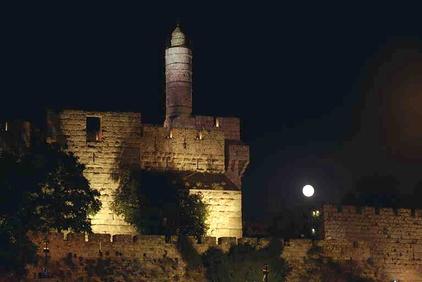Jerusalem is a holy city to three major faiths–Judaism, Christianity and Islam–and figures prominently in the Arab-Israeli conflict.
Since 1004 BCE, when King David established Jerusalem as the capital of his kingdom, there has been a continuous Jewish presence in Jerusalem, the holiest city in Judaism. Following the building of the Church of the Holy Sepulchre and the designation of other holy sites by Constantine the Great in 333 CE, Jerusalem became a destination of Christian pilgrimages. During Umayyad rule from 661 to 750 CE, the Dome of the Rock and the Al Aqsa Mosque were built on the site where the Jewish Temples had once stood, and Jerusalem became the third holiest city in Islam.

"The citadel" towers over the city walls of Jerusalem
Jews have constituted the largest ethnic group in Jerusalem since 1820. During the 19 years when Jordan occupied eastern Jerusalem and its holy sites (1948-1967), Jerusalem was divided. Jews were expelled from eastern Jerusalem and barred from visiting their holy places.
As a result of the Six Day War, the entire city of Jerusalem and its holy sites came under Jewish control. Israel reunified the city, extending Israeli law, jurisdiction and administration to the parts previously occupied by Jordan. The Israeli Knesset passed laws to protect holy sites and ensure freedom of worship to all, and offered Israeli citizenship to Jerusalem’s Arab residents, most of whom declined.
Since 1967, Jerusalem has become a focal point of the Palestinian-Israeli conflict. In 1980, Israel passed the Basic Law: Jerusalem Capital of Israel, reaffirming the unified Jerusalem as its eternal, undivided capital. Palestinians insist Jerusalem must be the capital of their intended state.
General references
- The Illustrated Map of Jerusalem, Dan Bahat, 1989.
- Atlas of the Arab-Israeli Conflict, Martin Gilbert, 1993.
- Freedom of Religion in Jerusalem, ed. Ruth Lapidot and Ora Ahimeir, 1999.
- Israel’s Foreign Relations: Selected Documents, 1947-1974, Ed. Meron Medzini, 1976.
- Whose Jerusalem?, Terence Prittie, 1981.
-
Jerusalem: An Archaeological Biography, Hershel Shanks, 1995.

